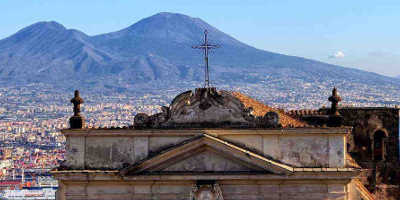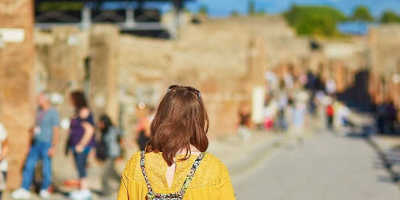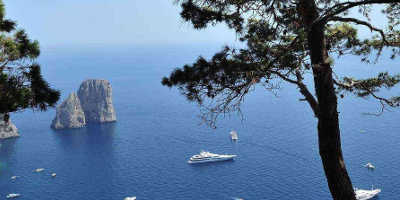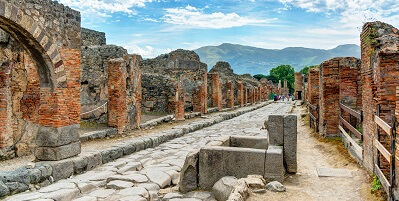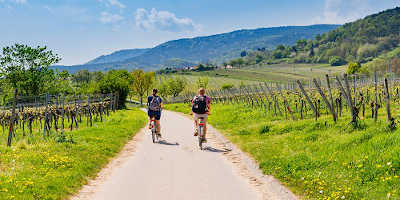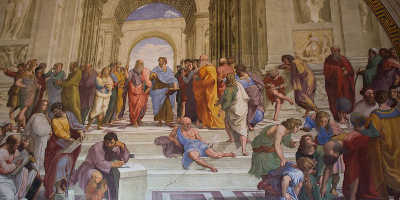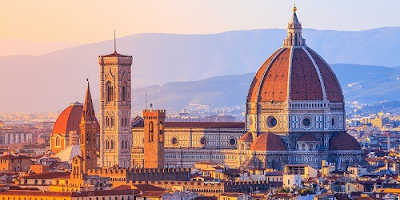Virtual Tour of Pompeii
Wander the ancient streets of Pompeii to uncover the intriguing history of the city where time was stopped with the volcanic eruption of Mount Vesuvius in 79AD.
When Mount Vesuvius erupted in 79 AD, spewing detritus into the air, it buried the ancient city of Pompeii under a cloud of ash where it remained untouched for over 1500 years. Uncovering the excavations has offered us a fascinating insight into the lives of the ancient inhabitants. Even if you can’t explore in person, enjoy a meander through the ancient streets to understand life of the Pompeii.
-
Porta Marina
Start your exploration by passing through the arches of the Porta Marina to enter the ancient city of Pompeii. This gateway to the harbour from the city facilitated the movement of goods and travellers to and from the city. There are two arches, a smaller one with steps for pedestrians and the larger arch for carts to pass through. As you pass under the archway you are walking in the footsteps of the city’s inhabitants thousands of years ago.
-
Tempio di Venere
Dedicated to Venus, the God of Beauty and patron god of Pompeii, the Tempio di Venere was one of the earliest buildings in Pompeii. Offering spectacular sweeping views over the Bay of Naples, the location was originally the site of private houses before several were destroyed to make way for the temple or converted to accommodation for the temple priests. The temple was destroyed in the 62 AD earthquake, and restoration was incomplete at the time of the 79 AD eruption of Mount Vesuvius. All that remains now of the temple are the altar and two statue bases.
-
Basilica
Built around 130 – 120 BC, the Basilica was a public building that housed the courts of law and other administration spaces for commercial transactions. It is the oldest Ancient Roman example of this type of building and was once lavishly decorated with statues and marble. The remains of the 28 large columns made of cut tile that you see once supported the 11-metre-high roof. Originally excavated in the 19th century, the ruins of the Basilica provide fascinating insight into the organisation of Pompeii civilisation.
-
Forum
Stepping out of the Basilica takes you into the Forum, the centre of daily life in ancient Pompeii. The rectangular area was once the town square and hosted several public administrative buildings, markets for trade and various temples. Meander the ruins here, first excavated in 1813, to discover the temples of Apollo, Vespasian and Jupiter, the town hall and municipal buildings. Towering ominously over the square in the background is Mount Vesuvius which, while peaceful and picturesque today, would have been a terrifying sight for the citizens of Pompeii during the eruption.
Before the eruption, the city’s citizens came to the Forum to purchase food and supplies at the various markets around the square. Food was sold at the Macellum, while wool is believed to have be traded at the Eumachia. The Granary was once a place for storage and trade of cereals and grains, but now houses many artifacts discovered during the centuries of excavations at Pompeii. Stored inside are relics of daily life including terracotta pottery and bottles, and larger items from the imperial villas such as marble tables and baths. But the most haunting collection is that of the body casts of the victims found buried in the ash, a melancholy reminder of the human cost of the eruption.
-
Theatre
The theatre was an important entertainment and meeting space in the time of ancient Pompeii, where comedies and tragedies were performed for the amusement of the public. The largest theatre, built into the natural hill for support, accommodated roughly 5000 spectators and is now used for special concerts and performances.
-
Lupanare
While several brothels have been uncovered in Pompeii, the Lupanare was the largest in the city, with 10 rooms to accommodate clients. The word Lupanare means ‘wolf-den’ in Latin, with prostitutes referred to as ‘lupa’ (she-wolf). Archaeologists first recognised the brothels because of the erotic paintings on the walls, examples of which can still be viewed inside. They are also recognised by the layout of multiple simple rooms housing a small stone bed, and the explicit graffiti carved into the walls. The racy images meant female tourists were originally not shown the brothel excavations, but now anyone can see inside these pokey ruins.
-
House of Sicarus
With much of the city dedicated to housing, we can learn a lot about domestic life in ancient Pompeii by perusing the excavations of the residents’ homes. While middle and lower-class houses were small, simple structures, upper class villas often contained lavishly decorated rooms and peaceful courtyard gardens.
The house of Siricus is unique example of an aristocrat’s residence, as judging by the layout, it was originally two houses that have been renovated to create one. The name Siricus comes from the owner, whose name is inscribed near the main entrances. Belonging to the political class, Siricus obviously valued wealth, as the inscription on the floor of the entrance reads “Salve Lucrum” (Welcome money). While some of the colourful frescoes that adorned the walls have been removed and displayed in the Naples museum, those that remain give you an idea of how the villa would have looked 2000 years ago.
This virtual tour offers a small taste of what can be explored on a tour of Pompeii in real life. We hope you will join us to dig a little deeper into the history of this amazing city.
Related article: How long does it take to tour Pompeii?

